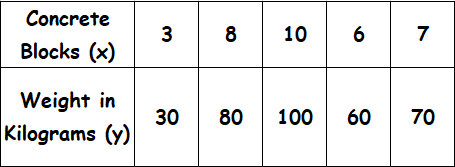WRITE EQUATIONS FOR PROPORTIONAL RELATIONSHIPS FROM TABLES
Two variables have a proportional relationship if the ratio of one variable to the other is constant. A proportional relationship between x and y can be modeled by the equation y = kx.
Example 1 :
Determine the constant of proportionality for each table and also write an equation for the relationship between x and y.

Solution :
To find the constant of proportionality, we have to divide y by x.
Ratio of y to x :
30/3 = 10
80/8 = 10
100/10 = 10
60/6 = 10
70/7 = 10
The ratio for each pair of x- and y-values is 10. So, the variables have a proportional relationship.
So, every concrete block weighs 10 kilograms. A proportional relationship between x and y can be modeled by the equation y = kx.
Here the value of k is 10.
So, the required equation for the relationship between x and y is y = 10x.
Example 2 :
Determine the constant of proportionality for each table.

Solution :
To find the constant of proportionality, we have to divide y by x.
Ratio of y to x :
15/5 = 3
30/10 = 3
18/6 = 3
27/9 = 3
6/2 = 3
The ratio for each pair of x- and y-values is 3. So, the variables have a proportional relationship.
So, every can of paint you could paint 3 bird houses.
A proportional relationship between x and y can be modeled by the equation y = kx.
Here the value of k is 3.
So, the required equation for the relationship between x and y is y = 3x.
Example 3 :
Determine the constant of proportionality for each table.

Solution :
To find the constant of proportionality, we have to divide y by x.
Ratio of y to x :
342/9 = 38
266/7 = 38
228/6 = 38
304/8 = 38
114/3 = 38
The ratio for each pair of x- and y-values is 38. So, the variables have a proportional relationship.
So, every vote for Faye there were 38 votes for Victor.
A proportional relationship between x and y can be modeled by the equation y = kx.
Here the value of k is 38.
So, the required equation for the relationship between x and y is y = 38x.
Example 4 :
Determine the constant of proportionality for each table.

Solution :
To find the constant of proportionality, we have to divide y by x.
Ratio of y to x :
1212/6 = 202
808/4 = 202
2020/10 = 202
606/3 = 202
1616/8 = 202
The ratio for each pair of x- and y-values is 202. So, the variables have a proportional relationship.
So,every chocolate bar has 202 calories.
A proportional relationship between x and y can be modeled by the equation y = kx.
Here the value of k is 202.
So, the required equation for the relationship between x and y is y = 202x.
Example 5 :
Determine the constant of proportionality for each table.

Solution :
To find the constant of proportionality, we have to divide y by x.
Ratio of y to x :
14/7 = 2
16/8 = 2
12/6 = 2
20/10 = 2
4/2 = 2
The ratio for each pair of x- and y-values is 2. So, the variables have a proportional relationship.
For each piece of chicken it costs 2 dollars.
A proportional relationship between x and y can be modeled by the equation y = kx.
Here the value of k is 2.
So, the required equation for the relationship between x and y is y = 2x.
Example 6 :
Determine the constant of proportionality for each table.

Solution :
To find the constant of proportionality, we have to divide y by x.
Ratio of y to x :
32/2 = 16
80/5 = 16
144/9 = 16
112/7 = 16
160/10 = 16
The ratio for each pair of x- and y-values is 16. So, the variables have a proportional relationship.
For every box of candy you get 16 pieces.
A proportional relationship between x and y can be modeled by the equation y = kx.
Here the value of k is 16.
So, the required equation for the relationship between x and y is y = 16x.
Kindly mail your feedback to v4formath@gmail.com
We always appreciate your feedback.
©All rights reserved. onlinemath4all.com
Recent Articles
-
AP Calculus BC Problems with Solutions
Apr 26, 25 05:49 AM
AP Calculus BC Problems with Solutions -
Digital SAT Math Problems and Solutions (Part - 150)
Apr 25, 25 11:46 AM
Digital SAT Math Problems and Solutions (Part - 150) -
AP Calculus AB Problems with Solutions (Part - 19)
Apr 24, 25 11:10 PM
AP Calculus AB Problems with Solutions (Part - 19)